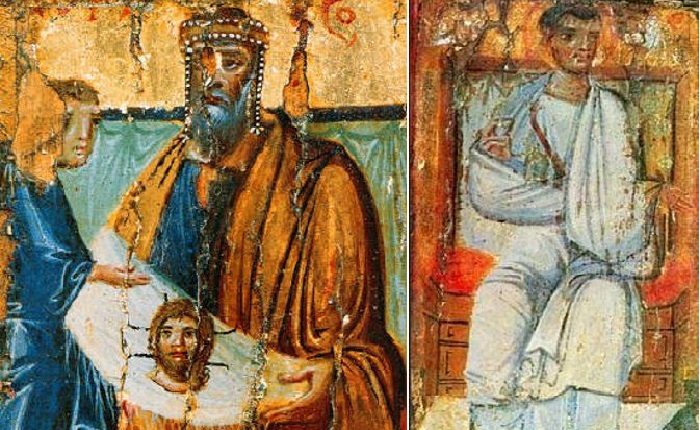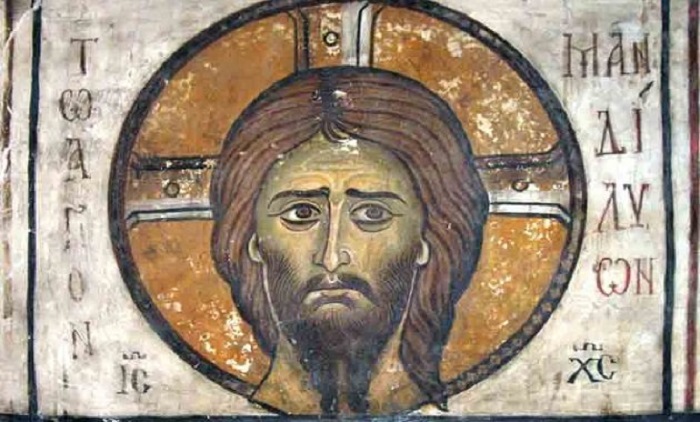The Doctrine of Addai the Apostle: The Syriac Doctrine of the Letter and Icon of the Lord
ܡܠܦܢܘܬܐ ܕܐܕܝ ܣܠܝܚܐ Malphonutho d-Addai Sliho
By Fr Alberto Meouchi priest of the Syriac Maronite Church of Antioch
The Doctrine of Addai is one of the sources of the most beautiful legends of the early Christians: The Legend of King Abgar Ukkāmā or “The Black”. The Doctrine of Addai is a Syriac document convincingly dated by some scholars to the fourth-fifth century – although some date it back to already the third century. There are, however, possible historical traces that could even take it back to the first century, such as the letters exchanged between King Abgar Ukkāmā and Roman Emperor Tiberius (reigning from 14-37 AD). The Abgarite kings were Roman clients.
Some elements in the letters point to the real historical context of the reign of King Abgar. King Abgar Ukkāmā ruled the Kingdom of Osroene with its capital of Urhoy (Edessa) from 4 BC to 7 AD, and 12 AD to ca. 40 AD. The author of the Syriac Doctrine of Addai might have known the tradition and possible content of some of the historical letters written by King Abgar and Emperor Tiberius (see Rammelli, 2009).
ܒܫܢܬ ܬܠܬܡܐܐ ܘܐܪ̈ܒܥܝܢ ܘܬܠܬ ܠܡܠܟܘܬܐ ܕܝܘ̈ܢܝܐ. ܘܒܡܠܟܘܬܗ ܕܡܪܢ ܛܝܒܪܝܣ ܩܣܪ ܪܗܘܡܝܐ: ܘܒܡܠܟܘܬܗ ܕܐܒܓܪ ܡܠܟܐ ܒܪ ܡܥܢܘ ܡܠܟܐ: ܒܐܝܪܚ ܬܫܪܝ ܩܕܡ ܒܝܘܡ ܬܪ̈ܥܣܪ̣. ܫܕܪ ܗܘܐ ܐܒܓܪ ܐܘܟܡܐ ܠܡܪܝܗܒ ܘܠܫܡܫܓܪܡ. ܪ̈ܫܢܐ ܘܡܝܩܪ̈ܐ ܕܡܠܟܘܬܗ. ܘܠܚܿܢܢ ܛܒܘܠܪܐ ܫܪܝܪܐ ܥܡܗܘܢ
According to historian bishop Eusebius of Caesarea (third-fourth century), Addai was one of the 72 disciples of Jesus Christ and a disciple of the apostle Touma (Thomas). An identification has also been found with the name of Thaddeus: Thaddaeus = Thaddaios = Addai. So, one can also come across Addai under the name of Thaddaeus of Edessa.
He is venerated as the evangelizer, together with Mari and Aggai of the kingdom of Osroene. Together with St. Thomas the Apostle, Addai is considered the founder of one of the Syriac churches, the Church of the East – now divided in Assyrian Church of the East, Ancient Church of the East, and Chaldean Catholic Church.
The Syriac Doctrine of Addai was probably one of the documents that Egeria knew (in the year 385) in the bishopric of Edessa, and that she comments on in her detailed account of her pilgrimage to the Holy Land, the Itinerarium Peregrinatio.
The first English text of The Doctrine of Addai was published in Ancient Syriac Documents (Cureton, 1864).
The original Syriac text, including English translation and notes, was published in London 12 years later (Philips, 1879). George Philips in his Preface tells us:
“The M.S. of which a portion is here edited, belongs to the Imperial Public Library of St. Petersburg. It is in fine condition, written in a bold Estrangelo character, comprising several words besides the one now published, and is apparently of the sixth century. It is the only known MS. which contains the Syriac text of «The Doctrine of Addai, the Apostle», entire.”
“There exists in the British Museum a MS. of this work, which forms one of the ancient Syriac documents edited and translated by late Dr. Cureton, and published after his death. That MS., however, is very imperfect. It does not contain so much as a half of the entire text, and consequently the value of the work in so mutilated a condition is greatly impaired”.
Father Alberto Meouchi is priest of the Syriac Maronite Church of Antioch in Chihuahua, Mexico.
Disclaimer: translated from the original Spanish see maronitas.org.
How to cite: Meouchi, Alberto, «Addai, Doctrina de», en Diccionario Enciclopedico Maronita. Chihuahua, Mexico: iCharbel.editorial (2019) 121-122.
Notes:
*N.B.: The Seleucid era corresponds to 312-311 B.C.
Bibliography:
CHAPMAN, John. «Doctrine of Addai» en HERBERMANN, Charles G. y otros (eds.), The Catholic Encyclopedia, Vol. V, New York: The Encyclopedia Press Inc., 1913;
CURETON, W., Ancient Syriac Documents Relative to the Earliest Establishment of Christianity in Edessa, Whitefish, Montana: Kessinger Publishing, 2010;
DERAMEY, J.P., Les origines de l’Eglise d’Edesse, France: RareBooksClub.com, 2013;
DUVAL, Rubens, Ancienne Littératures Chrétienne: II. La littérature syriaque, Paris: Librairie Victor Lecofre, 10 ed. 1990;
EGERIA, Itinerarium Peregrinatio, Pars Prima: Peregrinatio ad Loca Santa (recuperado de http://www.intratext.com/IXT/LAT0719/);
EUSEBIO DE CESAREA, Historia Eclesiástica, Ἐκκλησιαστικὴ ἱστορία. Textus: Eusebii opera in Patrologia Graeca 19 – 24, Paris: J. P. Migne, 1857 (https://www.hs-augsburg.de/~harsch/graeca/Chronologia/S_post04/Eusebios/eus_hi00.html);
GONNET, Dominique, «L’histoire d’Abgar, roi d’Édesse, ses sources bibliques et sa stratégie narrative (Eusèbe de Césarée, Historie ecclésiastique, livre I, 13)», Journée d’Agrégation, Lyon: 19 de noviembre 2005;
HABBI, J., «Addai, doctrina de», en FARRUGIA, Edward G. (dir.), Diccionario Enciclopédico del Oriente Cristiano, Burgos: Monte Carmelo, 2007;
RAMELLI, Ilaria L. E., Possible Historical Traces in the Doctrina Addai, USA: Gorgias Press, 2009;
The Teaching of Addai. Syriac text reproduced from edition by PHILLIPS., G. London, 1876. Translated by G. HOWARD. Pp. ix+117. (SBL Texts and Translations, 16, Early Christian Literature Series, 4), Chico, California: Scholars Press, 1981;
TILLEMONT, L., Les origines de l’Eglise d’Edesse, Paris: 1888;
TILLEMONT, L., Mémoires pour servir à l’histoire ecclésiastique des six premiers siècles, Vol. VI, Bruxelles: 1732.


























